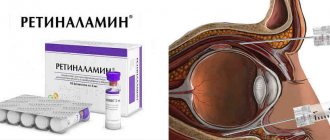Vazaprostan
Vasaprostan (active ingredient alprostadil) is a vasodilator, an analogue of endogenous prostaglandin E1. It is used mainly to treat chronic occlusive (blockage-related) diseases of the arteries. The drug improves blood circulation in the capillary bed, activates peripheral circulation, and exhibits a capillary protective effect. When administered intravenously, it relaxes smooth muscles, has a vasodilating effect, reduces total peripheral vascular resistance, and lowers blood pressure. Against the background of the action of vazaprostan, a reflex increase in minute blood volume and heart rate is observed. The drug improves the rheological characteristics of blood, makes red blood cells more elastic, reduces platelet aggregation (sticking together) of platelets, and promotes fibrinolysis (dissolution of blood clots and blood clots). Vazaprostan has an effect on metabolism, increases the utilization of glucose (primarily due to oxidation) and oxygen, reduces the production of free radicals and lysosome enzymes from macrophages and granulocytes, stimulates protein synthesis, has a positive effect on fat metabolism (inhibits the synthesis of “bad” cholesterol, reducing the concentration of low-density lipoproteins), inhibits the proliferation of smooth muscle tissue. By suppressing the proliferation of smooth muscle cells and inhibiting mitotic activity, the drug inhibits the growth of atherosclerotic plaques, and also helps reduce spasm of blood vessels. At the same time, the drug stimulates the smooth muscle “corset” of the intestines, uterus, bladder, and inhibits the secretion of gastric juice. Vazaprostan has another very specific area of application - the treatment of erectile dysfunction. When administered intracavernosally (into the cavernous bodies of the penis), the drug blocks alpha-1-adrenergic receptors dotting the tissues of the penis, relaxes the smooth muscles of the cavernous bodies, intensifies blood flow and improves blood circulation in the capillaries.
The dilation of the arteries of the penis increases blood flow to the glans, and venous outflow is limited, resulting in an erection. The drug begins to act in 5-10 minutes and retains its effect for 1-3 hours.
Vazaprostan plays an important role in the treatment of critical limb ischemia, which has developed, for example, against the background of obliterating atherosclerosis. In some cases, the use of the drug is the only alternative to limb amputation. Vazaprostan can help even with stage 4 critical limb ischemia. Thanks to the high effectiveness of the drug, it is possible not only to save the limb, but also to significantly improve the prognosis in the presence of gangrene. According to the Russian Academy of Medical Sciences, therapy with vasaprostan in patients with critical limb ischemia ensures the preservation of the integrity of the latter in 95% of cases. Another important aspect of the use of vazaprostan is ischemia of the lower extremities that develops as a result of diabetes mellitus. Thanks to improved glucose utilization, activation of metabolic and trophic processes in tissues, and other positive effects of prostaglandin E, patients experience wound healing and scarring of trophic ulcers. The best effect in such cases is obtained by combining vazaprostan with thioctic acid. The use of the drug is also justified in the case of reconstructive surgery, because vazaprostan prevents the development of thrombosis of the vascular prosthesis and restenosis (repeated narrowing of the artery lumen in the place where the stenosis was surgically eliminated).
Vazaprostan is available in the form of a lyophilisate for the preparation of a solution for infusion. The dosage regimen of the drug is individual.
Vazaprostan lyophilisate for the preparation of solution for inf 60 µg N 10
Active substance: alprostadil (alprostadil)
Lyophilisate for preparing a solution for infusion in the form of a white hygroscopic mass.
| 1 amp. | |
| alprostadil (clathrate complex with alfadex) | 60 mcg |
Excipients: alphadex (α-cyclodextrin), anhydrous lactose.
Glass ampoules (10) - cardboard packs.
pharmachologic effect
Prostaglandin E1 (PG E1) preparation. Improves microcirculation and peripheral circulation, has a vasoprotective effect.
When administered systemically, it causes relaxation of smooth muscle fibers, has a vasodilating effect, and reduces peripheral vascular resistance without changing blood pressure. In this case, there is a reflex increase in cardiac output and heart rate.
Helps increase the elasticity of red blood cells, reduces platelet aggregation and neutrophil activity, increases the fibrinolytic activity of the blood.
Has a stimulating effect on the smooth muscles of the intestines, bladder, and uterus; suppresses the secretion of gastric juice.
Indications of the drug Vazaprostan®
chronic obliterating diseases of the arteries of stages III and IV (according to Fontaine classification).
Dosage regimen
The solution must be prepared immediately before the infusion. The lyophilisate dissolves immediately after adding saline. At first, the solution may appear milky-cloudy. This effect is created by air bubbles and is not significant. After a short time the solution becomes transparent.
It is not allowed to use a solution prepared more than 12 hours ago.
Intra-arterial administration
Lyophilisate for the preparation of solution for infusion: 1 amp./20 mcg alprostadil
To obtain a solution for intravenous administration, the contents of 1 ampoule of lyophilisate (corresponding to 20 mcg of alprostadil) should be dissolved in 50 ml of physiological solution. In the absence of other prescriptions, half an ampoule of Vazaprostan (corresponding to 10 mcg of alprostadil) should be administered intravenously over 60-120 minutes using an infusion device. If necessary, especially in the presence of necrosis, under strict tolerance control, the dose can be increased to 1 ampoule (20 mcg alprostadil). This dose is usually used as a single daily infusion.
Intravenous administration
Lyophilisate for the preparation of solution for infusion: 1 amp./20 mcg alprostadil
To obtain a solution for intravenous administration, the contents of 2 ampoules of lyophilisate (corresponding to 40 mcg of alprostadil) should be dissolved in 50-250 ml of physiological solution and the resulting solution should be administered intravenously over 2 hours. This dose is applied 2 times a day.
Or the contents of 3 ampoules (corresponding to 60 mcg of alprostadil) are dissolved in 50-250 ml of physiological solution and administered intravenously for 3 hours 1 time per day.
The average duration of treatment is 14 days; if the effect is positive, treatment with the drug can be continued for another 7-14 days. If there is no positive effect within 2 weeks from the start of treatment, further use of the drug should be discontinued.
Before use, consultation with a specialist is required. The method of administration and dosage regimen of a particular drug depend on its release form and other factors. The optimal dosage regimen is determined by the doctor. Storage mode, interactions and side effects are indicated in the instructions.
Side effect
- From the central nervous system and peripheral nervous system: headache, dizziness, convulsive syndrome, increased fatigue, feeling of malaise, impaired sensitivity of the skin and mucous membranes.
- From the cardiovascular system: decreased blood pressure, chest pain, heart rhythm disturbances, AV block.
- From the digestive system: discomfort in the epigastrium, nausea, vomiting, diarrhea.
- From the musculoskeletal system: hyperostosis of long tubular bones (with therapy for more than 4 weeks).
- Allergic reactions: skin rash, itching.
- Local reactions: erythema, swelling, pain, sensory disturbance, phlebitis (proximal to the IV injection site).
- Other: increased sweating, hyperthermia, swelling of the limb into which the infusion is administered.
- Laboratory indicators: leukocytosis, leukopenia, increased titer of C-reactive protein, increased transaminase levels.
- Rarely: arthralgia, confusion, central convulsions, fever, chills, bradypnea, psychosis, renal failure, anuria. Several cases of pulmonary edema and acute left ventricular failure have been reported.
- Extremely rare (up to 1% of cases): shock, acute heart failure, hyperbilirubinemia, bleeding, drowsiness, bradypnea, decreased respiratory function, tachypnea, anuria, renal dysfunction, hypoglycemia, ventricular fibrillation, 2nd degree AV block, supraventricular arrhythmia, tension neck muscles, increased irritability, hypothermia, hypercapnia, skin hyperemia, hematuria, peritoneal symptoms, tachyphylaxis, hyperkalemia, thrombocytopenia, anemia.
- Side effects associated with the use of the drug or the catheterization procedure itself are reversible after reducing the dose or stopping the infusion.
Contraindications for use
- chronic heart failure in the stage of decompensation;
- severe heart rhythm disturbances;
- exacerbation of ischemic heart disease;
- myocardial infarction in the last 6 months;
- pulmonary edema;
- infiltrative lung diseases;
- chronic obstructive pulmonary diseases;
- liver dysfunction (increased levels of AST, ALT, GGT);
- history of liver disease;
- diseases accompanied by an increased risk of bleeding (peptic ulcer of the stomach and duodenum, severe damage to the blood vessels of the brain, proliferative retinopathy with a tendency to bleeding, extensive trauma);
- concomitant therapy with vasodilators and anticoagulant drugs;
- pregnancy;
- lactation period (breastfeeding);
- age under 18 years (efficacy and safety have not been established);
- hypersensitivity to alprostadil and other components of the drug.
Vazaprostan should be prescribed with caution in case of arterial hypotension, cardiovascular failure (monitoring the volume load of the carrier solution is required), patients on hemodialysis (treatment should be carried out in the post-dialysis period), patients with type 1 diabetes mellitus, especially with extensive vascular lesions.
Use during pregnancy and breastfeeding
- The use of Vazaprostan during pregnancy is contraindicated.
- If it is necessary to use the drug during lactation, breastfeeding should be stopped.
Use in children
Contraindication: age under 18 years (efficacy and safety have not been established).
special instructions
Vazaprostan can only be used by doctors who have experience in angiology, are familiar with modern methods of continuous monitoring of the cardiovascular system and have the appropriate equipment for this.
When carrying out therapy with Vazaprostan, blood pressure, heart rate, biochemical blood parameters, blood clotting indicators should be monitored (in case of disorders of the blood coagulation system or during simultaneous therapy with drugs that affect the coagulation system).
Instructions for use VASAPROSTAN
The solution must be prepared immediately before the infusion. The lyophilisate dissolves immediately after adding saline. At first, the solution may turn out milky-cloudy. This effect is created by air bubbles and is not significant. After a short time the solution becomes transparent.
It is not allowed to use a solution prepared more than 12 hours ago.
Intra-arterial administration
To obtain a solution for intravenous administration, the contents of one ampoule of lyophilisate (corresponding to 20 mcg of alprostadil) should be dissolved in 50 ml of physiological solution. In the absence of other prescriptions, half an ampoule of Vazaprostan (corresponding to 10 mcg of alprostadil) should be administered intravenously over 60-120 minutes using an infusion device. If necessary, especially in the presence of necrosis, under strict tolerance control, the dose can be increased to 1 ampoule (20 mcg alprostadil). This dose is usually used as a single daily infusion.
If intravenous administration of the drug is carried out through an installed catheter, depending on tolerability and severity of the disease, a dose of 0.1-0.6 ng/kg body weight/min is recommended with administration of the drug over 12 hours using an infusion device (corresponding to 1/4- 11/2 ampoules of Vazaprostan).
Intravenous administration
To obtain a solution for intravenous administration, the contents of two ampoules of lyophilisate (corresponding to 40 mcg of alprostadil) should be dissolved in 50-250 ml of physiological solution and the resulting solution should be administered intravenously over 2 hours. This dose is applied 2 times a day.
Or the contents of 3 ampoules (corresponding to 60 mcg of alprostadil) are dissolved in 50-250 ml of physiological solution and administered intravenously for 3 hours 1 time per day.
The average duration of treatment is 14 days; if the effect is positive, treatment with the drug can be continued for another 7-14 days. If there is no positive effect within 2 weeks from the start of treatment, further use of the drug should be discontinued.
In patients with renal failure (serum creatinine more than 1.5 mg/dL)
IV administration of Vazaprostan should be started with 20 mcg for 2 hours. If necessary, after 2-3 days the single dose can be increased to 40-60 mcg.
For patients with renal and heart failure
the maximum volume of administered fluid is 50-100 ml/day. The duration of treatment is 4 weeks.


